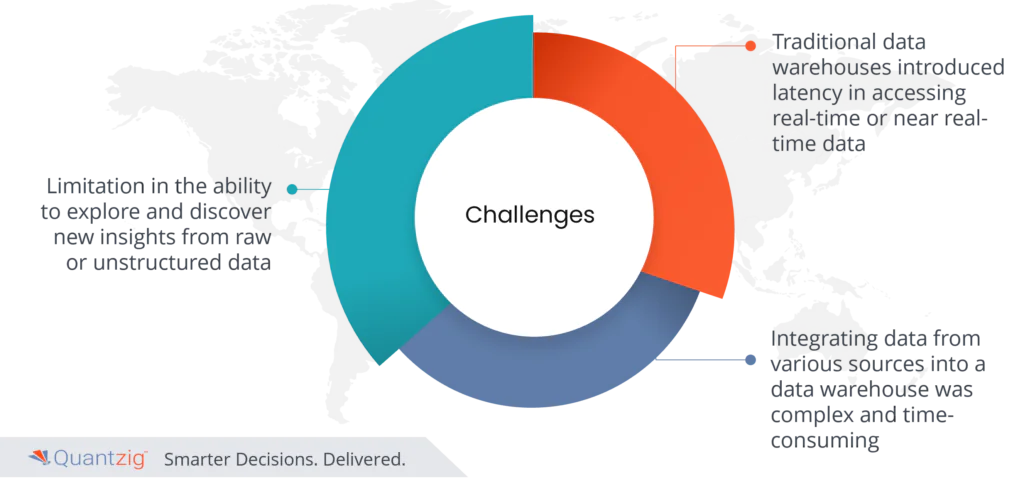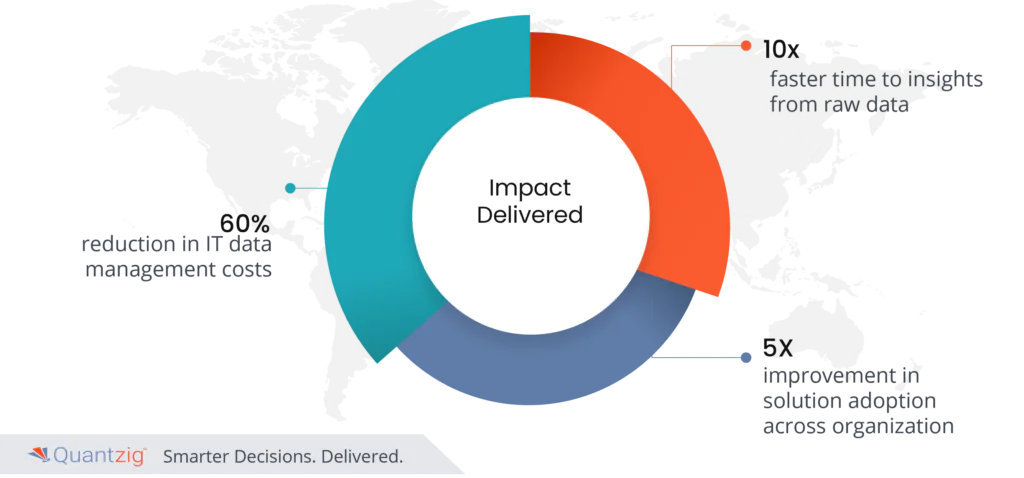Table of Contents
Introduction
In today’s data-driven landscape, the convergence of a data warehouse and a data lake stands as the compelling path forward for organizations seeking to optimize their data management and analytics capabilities. The integration of these two powerful data architecture principles fosters a harmonious ecosystem, where structured and unstructured data coexist seamlessly, enabling comprehensive data integration, storage, and analysis. This strategic merger empowers businesses to enhance data accessibility, promote cross-functional collaboration, and derive deeper insights from a unified and scalable platform. In this article, we’ll explore the compelling rationale behind why merging a data warehouse and a data lake represents the definite path forward for modern enterprises.
Make the most of your data!
Connect with us for tailor-made solutions
Importance of merging a Data Warehouse and Data Lake
- Functional benefits of both data lake and data warehouse:
A data warehouse and a data lake each offer distinct functional benefits that, when integrated, create a formidable data management ecosystem. Data Warehouse is considered a large repository of organizational data that is accumulated from a broad range of external and operational data sources. The data is filtered, structured, and already processed for any particular purpose. A Data warehouse systemically pulls processed data from various external partner systems and internal applications for analytics and advanced querying. On the other hand, A data lake is a highly scalable data storage area that stores a huge volume of raw data in its original format. You can store different types of data with a data lake with no fixed limitation on file or account size. The data can be semi-structured, structured, or even unstructured.
The combined approach enables businesses to harness the strengths of both paradigms, facilitating seamless data integration, enhanced data accessibility, and comprehensive analytics capabilities. This synergy empowers organizations to derive deeper insights, make data-driven decisions, and achieve a competitive edge in today’s dynamic market landscape.
- Data ingestion, data transformation, and data analysis within a single environment:
Merging a data warehouse and data lake creates a unified environment that streamlines data ingestion, transformation, and analysis, offering unparalleled functional benefits. Data ingestion capabilities of the data lake allow seamless acquisition and storage of diverse, raw data, while the data warehouse handles structured data ingestion efficiently. The integration ensures a consistent data model and a single source of truth, facilitating smooth data transformation processes across the combined platform. With data transformation and preparation occurring within the same environment, data engineers and analysts can collaboratively process and refine data, leading to comprehensive and accurate insights during the data analysis phase. This cohesive approach fosters greater data integrity, accessibility, and analytical prowess, empowering organizations to make well-informed decisions and thrive in the data-driven era.
- Integrated Analytics and Reporting:
In a lake house architecture, cross-functional integration is facilitated by unifying data processing and storage. By combining data warehousing and data lake capabilities, different teams can access and analyze data using their preferred tools while maintaining data consistency and enabling collaboration across the organization. This architecture streamlines data sharing and ensures that insights can be derived from a holistic and up-to-date dataset.
Simultaneously, integrated reporting provides real-time and holistic views of the organization, empowering stakeholders to stay informed and agile in their strategic planning and execution. This convergence empowers businesses to harness the full potential of their data assets, yielding a competitive advantage in today’s dynamic and data-centric business landscape.
Challenges present in a lack of a Data Warehouse and Data Lake
The integration of a data warehouse and a data lake presents multifaceted challenges, stemming from disparate data types, storage paradigms, retention policies, and agility requirements. Merging structured and unstructured data demands meticulous transformation efforts. Ensuring robust security across hybrid environments entails complex governance, amplifying the challenge. The absence of a seamless merging strategy can result in redundant data, increased storage costs, and reduced data quality. Moreover, managing access controls and ensuring compliance becomes complex, impeding effective data governance. To optimize the migration process, a robust integration plan is essential to harmonize data, streamline processes, and ensure data integrity and security.
Benefits of merging a Data Warehouse and Data Lake
- The Gold-Silver-Bronze (GSB) approach within the lake house architecture, also known as the Medallion architecture, offers a scalable and versatile solution. In this framework, ‘Gold’ represents curated and highly governed data for critical analytics, ‘Silver’ holds semantically enriched data for diverse user needs, and ‘Bronze’ accommodates raw, unprocessed data for exploratory benefits. This tiered architecture optimizes storage, processing, and access costs while catering to varied user requirements. It balances data quality, agility, and cost-effectiveness, ensuring that organizations can effectively leverage their data lake for strategic decision-making and insights across the entire data spectrum.
- If you merge the data lake and data warehouse in a simplified data architecture, it will enhance data agility, reduce data movement, and improve overall operational efficiency. By combining these two components, data agility is enhanced through seamless data access and sharing, enabling quicker responses to changing business needs. The reduced data movement between the warehouse and the lake minimizes processing delays and optimizes resource utilization, leading to improved operational efficiency. This streamlined approach eliminates data redundancies and fragmentation, fostering a more coherent data environment that facilitates better analysis and decision-making. Centralized data governance, data quality, and security are reinforced, promoting trust in the organization’s insights.
- Merging an enterprise data warehouse and data lake analytics provides numerous advantages through advanced analytics and machine learning integration. By combining structured and unstructured data, organizations can gain a comprehensive view for more accurate and prescriptive analytics. This empowers data-driven decision-making and unlocks deeper insights, enabling the identification of hidden patterns and trends. Leveraging algorithms and statistical techniques, businesses can make informed predictions and optimize processes for better outcomes. The unified platform fosters innovation, agility, and scalability while ensuring secure data processing.
Success Story:
How we helped a leading Digital Marketing Company to merge a data warehouse and a data lake seamlessly
Client Details: A leading Digital Marketing company, located in the United States and have a highly dedicated workforce of 25,000 employees.
Challenges:

- Limitation in the ability to explore and discover new insights from raw or unstructured data:
The client was facing limitations in exploring and discovering new insights from raw or unstructured data. This challenge likely arose due to the absence of effective data analysis tools and techniques, hindering the extraction of valuable information. Unstructured data, such as text, images, and audio, can be challenging to interpret without appropriate algorithms and methodologies. The lack of data organization and standardization made it difficult to identify patterns, trends, and correlations, leading to missed opportunities for data-driven decision-making.
- Traditional data warehouses were typically optimized for batch processing, which introduced latency in accessing real-time or near-real-time data:
They were facing challenges with traditional data warehouse tools due to their focus on batch processing, resulting in delays when accessing real-time data. This latency hindered their ability to make informed, timely decisions and respond quickly to dynamic market conditions. In today’s fast-paced business landscape, real-time insights are crucial for staying competitive and agile. By adopting modern data warehouse solutions and data lake solutions that support real-time data processing, the client could overcome these challenges and gain a competitive edge through faster and more accurate decision-making processes.
- Integrating data from various sources into a data warehouse was complex and time-consuming:
The company was facing significant challenges while integrating data from diverse sources into its data warehouse. The complexities and time-consuming nature of the task stemmed from the need to handle varying data formats, structures, and schemas from disparate systems. Additionally, ensuring data consistency, accuracy, and quality across the integrated data was a major obstacle. Dealing with large volumes of data and establishing effective data transformation processes also contributed to the complexity. Furthermore, the client had to address potential data conflicts and ensure seamless data flow between different sources. These challenges hindered the timely and efficient consolidation of data into their data warehouse.
Facing similar challenges?
Connect with us for tailor-made solutions
Solutions:
- Data Governance and Metadata Management capabilities:
Quantzig helped the client by enhancing their data governance and metadata management capabilities. Through meticulous analysis, implementation, and monitoring, we enabled their company to establish robust data governance frameworks, ensuring data quality, security, and compliance. Effective metadata management solutions were devised, enabling comprehensive data documentation, lineage tracking, and easy accessibility.
- Advanced Query and Analytics Capabilities:
Our expert data warehouse architect empowered the client with advanced query and analytics capabilities, that revolutionized their data-driven processes. Leveraging cutting-edge data warehousing service and expertise, we provided bespoke solutions for complex data queries, enabling the client to derive meaningful insights from vast datasets in real time. The implementation of advanced analytics tools and techniques facilitated predictive modeling and trend analysis, enhancing decision-making, and uncovering hidden patterns.
- Integration with Data Processing and Analytics Tools:
By conducting an in-depth assessment of their existing infrastructure and business needs, Quantzig identified optimal integration points and customized solutions. This facilitated smooth data flow between various systems, enabling real-time data processing and analysis. With enhanced connectivity between disparate tools, they gained a unified view of their data, leading to quicker and more accurate decision-making. Successful integration empowered the company to leverage its data ecosystem effectively, resulting in better insights, increased productivity, and greater agility in responding to market dynamics.
- DataOps and self-serve analytics capabilities:
Quantzig revolutionized the client’s data operations and analytics capabilities by implementing a robust and self-service analytics platform. This platform streamlined data flows, and ensured seamless data integration, processing, and storage. The self-service analytics platform empowered non-technical users to access, explore, and analyze data independently, reducing dependency on IT teams. Through automated data pipelines and analytics tools, the client experienced faster data processing and real-time insights. This enhanced agility and data-driven decision-making, fostering innovation and growth.
Impact Delivered:

- 60% reduction in IT data management costs
- 10x faster time to insights from raw data
- 5X improvement in solution adoption across the organization
Discover the power of unified data insights! Now seamlessly merge a data warehouse and a data lake, revolutionizing data management and analytics. Contact Quantzig to unleash the full potential of your data assets and gain a comprehensive view of your business!


